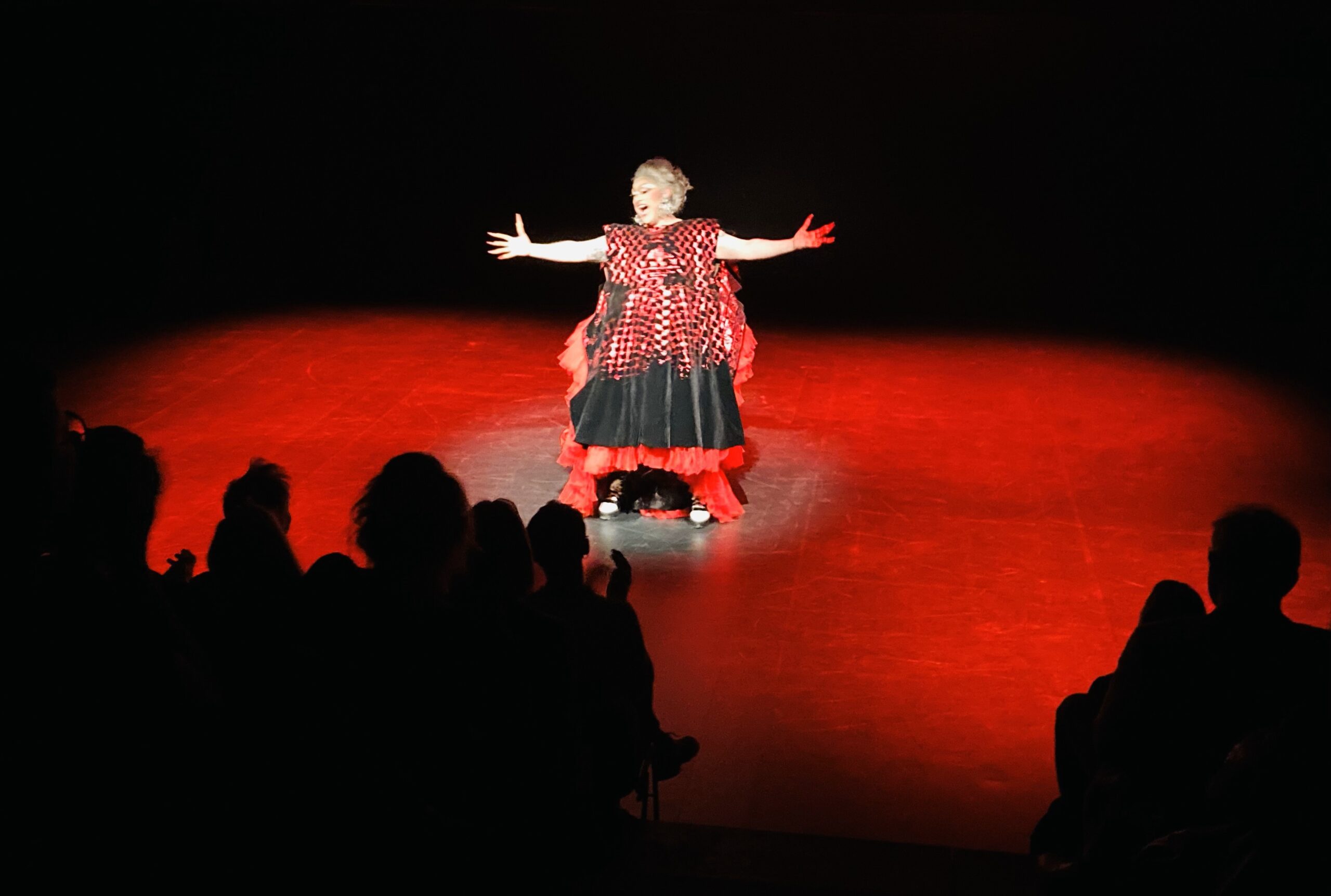Sigrid Stigsdatter curated the 9th volume of New Sh*t – a performance night at Dansehallerne showcasing works that are raw, new to the scene or have not had the chance to show at Dansehallerne, yet – curated by a different member of the Copenhagen dance scene each time. This text is a curatorial insight, a talk with Sigrid Stigsdatter, as much as it is an observation of the evening.
The evening begins. It’s a drag number. Purple cones of light move over the dance carpet and Sako Dersahakian appears as his Drag-character Evita Kedavra in between them. Evita is wearing a pink dress and a sash draped across it, which says Miss Lebanon. The dress only stays for a while. She is lip-syncing and posing for the audience. Just then, in a sudden moment, she rips off the dress and the Miss Lebanon sash. Evita Kedavra starts belly-dancing in a two-piece that was hidden just before. She is approaching the audience, coming very close. I can see her belly moving, as well as her teasing and luscious smile.
Sigrid Stigsdatter [SS]: “I really love to watch belly dancing. I used to do belly dancing when I was a kid. In many ways, this is also how I started my own dance journey: belly-dancing, Flamenco and gymnastics. And I thought, okay, there’s a very beautiful collision of belly dance and the chance to show Sako’s work at Dansehallerne, someone that maybe would not usually be curated there, because it’s a different genre and to invite a performer that is super strong and really amazing.”
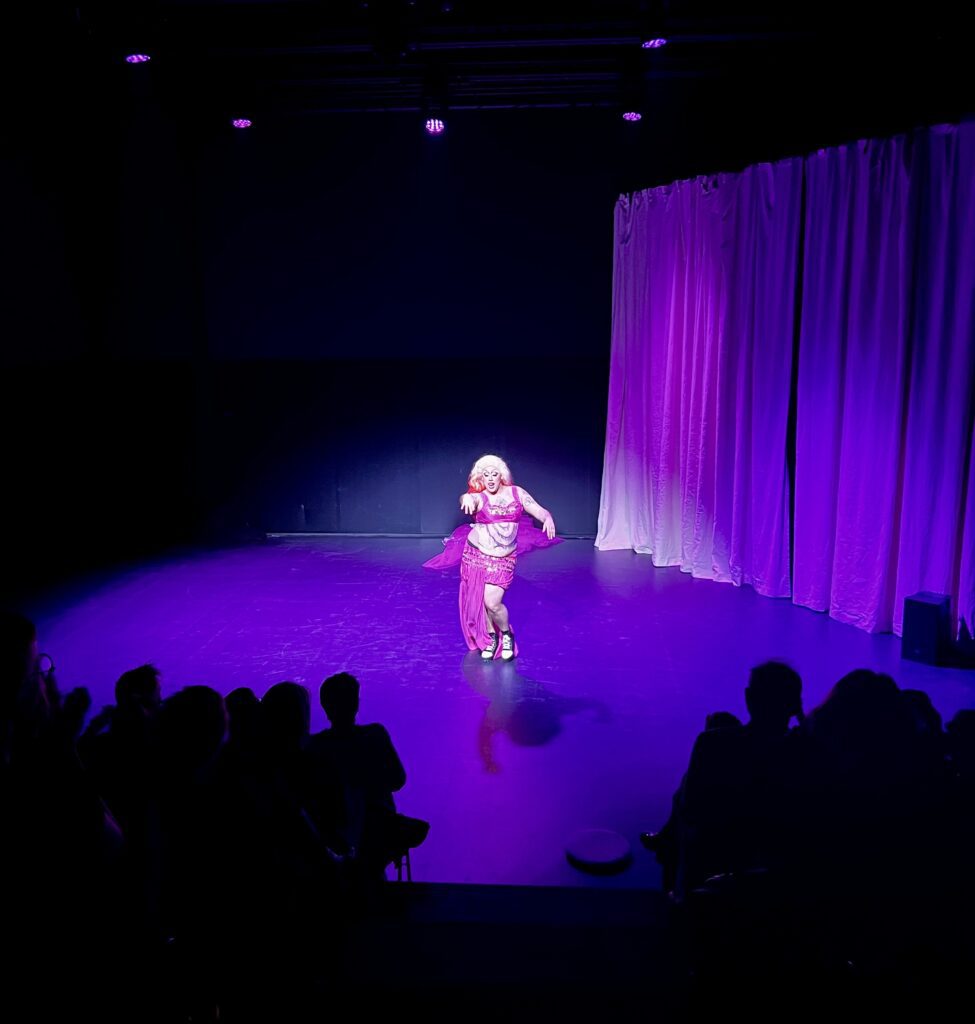
But to start earlier:
Pauline Michel [PM]: “What were your first thoughts on how to shape this evening?”
SS: “It’s funny, because as a curator I was like, “How should I use this power? How should I care for this responsibility?” I had sleepless nights, with these questions: will the audience like it? Should there be a work that talks about the current state the world is in, and should it be only local artists, should there be an international artist as well? So, I had all those thoughts at first.
And then I was thinking about what kind of emotional journey I would like to take the audience on when watching and what it is that I like to see in performance myself right now?
In a way the evening is curated much like how I make choreographic work myself. I usually have some theatricality. I have something that is built on physical practice and then I often also do something that is a bit entertaining. I wanted the audience to feel entertained but also challenged. When showing three works, it was important to me, that you don’t come out and you think like, “I like this one, but I didn’t like that one.” But it is works, which complement and counter each other and that are more as if you got a full meal, a full evening.”
I hear the sounds of heels on the floor. The stage is dark and a tall white curtain is hiding its back corner. In SHOW&TELL, the second piece of the evening, Ingrid Meier Andersen enters from behind the curtain. She sits down on a stool and lights a candle. Her smile is broad, and she looks at the audience as she moves her head back a little and starts to sing:
“She came from the outside
She gave her all and then left
But is it ever enough
to wear stockings, lipstick and heels?
I don’t know, if we have a show
‘Cause what’s a show in today’s world?”
SS: “Ingeborgs work comes from a branch of performance, I like a lot. It is choreographic work that works with a clear character. It works with theatricality, with both voice and body as its main material. In my imagination this character used to be very virtuous, but now she’s kind of falling apart. It is dealing with the different bodies and textures that her character has gone through in her career as a showgirl. It becomes this very existential work. Ingeborg has this very expressive face and in SHOW&TELL you really get to see what she is capable of.”
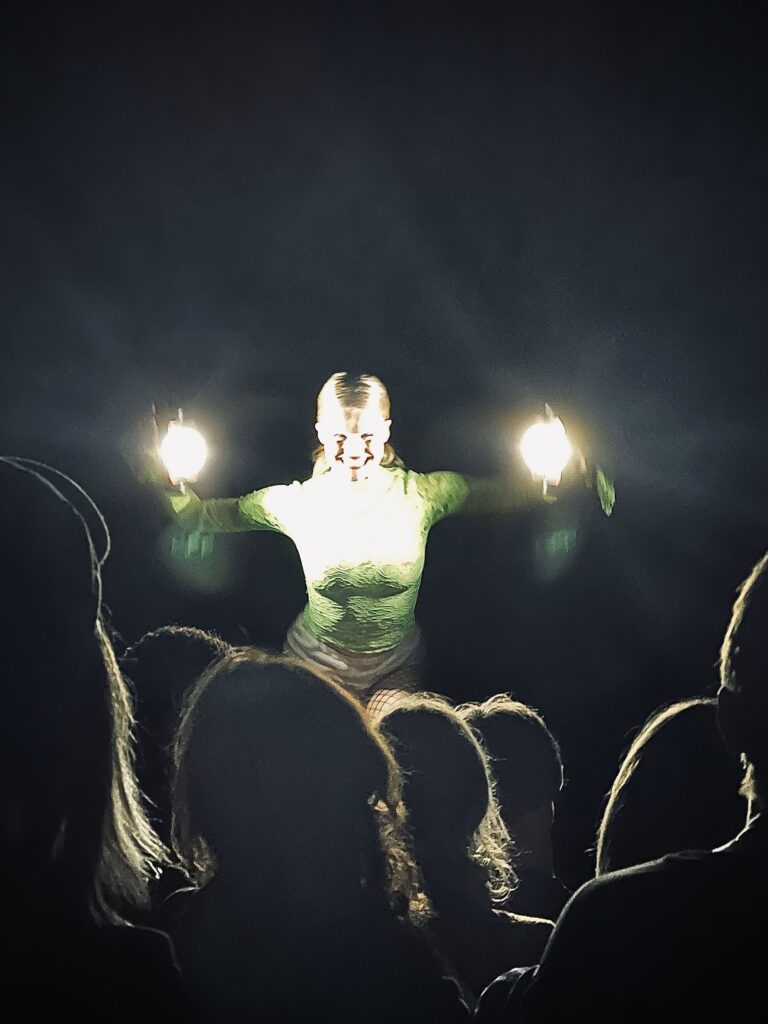
A moment later Ingeborg Meier Andersen enters the stage through the curtain again, holding two spotlights in her hands. She is wearing pumps, fish-net stockings, white underwear on top and a neon green lace shirt. Ingeborg Meier Andersen is posing between the spotlights she is holding, while her smile is wide. She is lighting parts of her body and turning the spotlights around to direct them towards the audience: “Me/ You / Me/ You”
Next to the lights the smile shifts. The character’s face slips away, the smile comes back, or her face looks labored and strained. She throws her long leg up in the air but finds herself fallen onto the floor a second later. She is posing with decorative arms or high lifted legs, humorously counteracting the positions with different grimaces, until she is sitting on the floor and embraces and kisses her knee soundfully.
{intermission} Klara Lopez aka djG0thzillahis playing, people are chatting in front of the bar.
As the third of the group and invited artists Elisa Zuppini, Italian-born choreographer and performer based in Amsterdam, is showing The Knot.
SS: “What all three works really have in common is a very strong presence. With Elisa’s work you get to dive into her physical practice and focus on the body.
She has meticulously been working on her own movement practice throughout many years and it’s extremely detailed. It is very sculptural and architectural.
What she does so elegantly is weaving concepts and theory into the practice. In The Knot there is nothing around except from two speakers. And the way she works with sound is also very particular. It is an underlying atmosphere rather than that it is music that you dance to.”
As I enter the audience room again, Elisa Zuppini is lying on stage, dressed in black. Her legs are widespread. She is resting on her underarms, and her gaze meets the audience blankly. The soundscape Sigrid describes appears like a recurring bark or hooter to me. I can hear it increasing in level and speed and then it disappears.
Elisa is turning around, crawling backwards on her knees. She is coming to standing, her knees still bent and her arms moving in front of her, snakelike through the air. Her movements are shifting in energy. In moments Elisa Zuppini is remaining still, or slowly molding into sculptural positions, in others she is moving across the floor rapturously. Her hair covers most of her face and her shoelaces are undone, but she does not trip.
I see Elisa Zuppini moving with accuracy and strength as well as one image returning of her sitting back with her legs being lifted, opened in a V-shape up in the air.
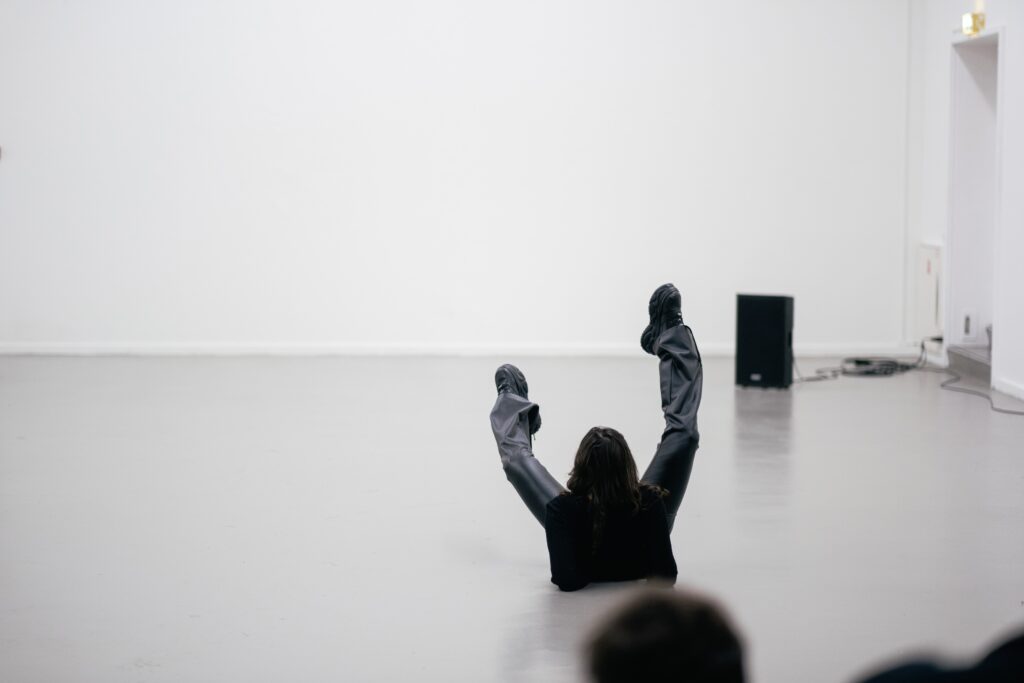
In Elisa Zuppini’s own writing on The Knot she quotes Jean-Luc Mouléne, a French and conceptual artist: “Because a knot is a figure, but a figure that goes against our habitual binary way of thinking, since it has no inside or outside. There is no territory: there are several surfaces, yet no territory.”
I start to imagine Elisa’s positions, her arms as a momentary part of a knot. A knot that is only a situation and whose entanglement and innate relations becomes visible to me through Elisa’s movement and shifting positions.
SS: “Elisa is continuously interested in the body, in movement, and in practice. I find this really impressive about her work. When I was watching the piece, I thought it’s actually so few performances I see now, where the body and the practice is the main choreographic subject in a way. It felt really refreshing to me.
When thinking about whom to invite I was also thinking of what I miss a bit in the dance scene in Copenhagen. I actually think, that we have a really beautiful dance scene here and that there is more and more dance and performance to watch. In many other places, it feels like things are getting harder, but here somehow it feels that dance has a momentum. Let’s hope it lasts.
But I miss seeing international mid-career artists, let’s say. So, artists that are not only emerging, but also don’t have a big audience just yet. Elisa showed a snippet of her work at Scoop festival by Dance Cooperative in Copenhagen last fall – in a showcase of excerpts of works by the artists of Jacuzzi dance Space in Amsterdam. So, I also thought, there’s already this small connection to Copenhagen and that maybe people have seen a little bit and are curious to see more.”
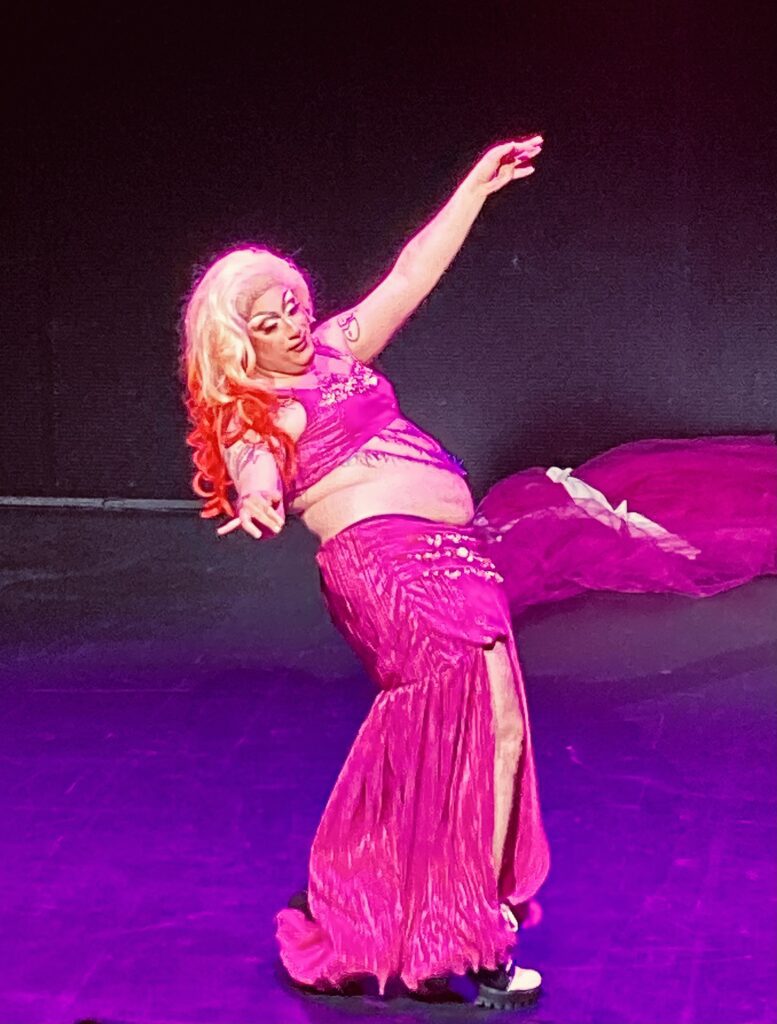
Sako Dersahakian is entering the stage a second time; as Evita Kedavra in a spectacular (self-designed) dress: red and black, ornamented and layers of red tulle on the back (see the first photo). When she starts turning it looks like fire. It’s Ayya Se3al 3arabeh? (When is the Arabic?) Act 2. or an act of revolutionary lip-sync. In his work Sako Dersahakian is busy with intersections of Queer- and Arabness. His work makes visible that they are not separate strands of identities, but interwoven ones that have always existed together.
As Evita Kedavra Sako Dersahakian is lip-syncing an interpretation of a poem by Nizar Qabbani, written in 1978 during the Civil War in Lebanon.
Here there is a part of its English translation:
“O Beirut, O Mistress of the World
[…]
Rise in honour of the forests
Rise in honour of the rivers
Rise in honour of the rivers and the valleys
And of humanity
Rise in honour of humanity
Rise O Beirut
Rise
The revolution is born in the womb of sorrows
O Beirut
O Beirut”
SS: “Sako was telling me that he has been wanting to perform this song for a long time but was missing the right context. The black box at New Sh*t felt like the perfect setting for this number – and extremely important in the context of the current Israeli attacks Beirut is under right now.”
As the song ends Evita Kedavra is standing in front of the audience. Her face is shining in the stage lights, her lips are vibrating, and her hands are stretched out towards the audience and appear so wide, because of the long red fingernails she is wearing.
SS: “I was thinking about how today our attention is more dispersed. Even in the way that we watch performances: We see a lot of pieces in the black box now where you can also come and go, and you can act more like you want. That is great of course.
But for me, there is also something super beautiful and very powerful about sitting together, with people doing the same thing at the same time. Even if you have your own experience, you join in with a common attention. It’s a little bit like singing together, you know; that you put the intention into something altogether.
I think that keeps the theatre so… powerful for me. I guess that is similar to what we do when we walk on the streets, and we demonstrate – like you gather around something, and you put your intention to that.”
When I step outside, I have experienced three different artists and a selection of works that have been versatile and compelling to me. They have entertained me as much as they asked for my attention and made me watch them closely. I am still thinking about SHOW&TELL and whether I want to laugh with its humor, or whether I only want to feel its tragedy. I am not sure, yet. As I leave my mind and belly feel satisfyingly full.
Here there is a last word from Sigrid Stigsdatter, originally said at the beginning of the night in her opening speech: “I truly believe that art can create change in the world. As the west turns towards the right, we need, more than ever, spaces where we can experience alternatives—where we dare to stay with the abstract, the intuitive, the emotional, the erotic, the sensual, the senses, where we can say free palestine and call for trans, queer and women’s rights.”
